Ornette Coleman | ||
| Allmusic Biography : One of the most important (and controversial) innovators of the jazz avant-garde, Ornette Coleman gained both loyal followers and lifelong detractors when he seemed to burst on the scene in 1959 fully formed. Although he, and Don Cherry in his original quartet, played opening and closing melodies together, their solos dispensed altogether with chordal improvisation and harmony, instead playing quite freely off of the mood of the theme. Colemans tone (which purposely wavered in pitch) rattled some listeners, and his solos were emotional and followed their own logic. In time, his approach would be quite influential, and the quartets early records still sound advanced many decades later. Unfortunately, Colemans early development was not documented. Originally inspired by Charlie Parker, he started playing alto at 14 and tenor two years later. His early experiences were in R&B; bands in Texas, including those of Red Connors and Pee Wee Crayton, but his attempts to play in an original style were consistently met with hostility both by audiences and fellow musicians. Coleman moved to Los Angeles in the early 50s, where he worked as an elevator operator while studying music books. He met kindred spirits along the way in Don Cherry, Charlie Haden, Ed Blackwell, Bobby Bradford, Charles Moffett, and Billy Higgins, but it was not until 1958 (after many unsuccessful attempts to sit in with top L.A. musicians) that Coleman had a nucleus of musicians who could play his music. He appeared as part of Paul Bleys quintet for a short time at the Hillcrest Club (which is documented on live records), and recorded two very interesting albums for Contemporary. With the assistance of John Lewis, Coleman and Cherry attended the Lenox School of Jazz in 1959, and had an extended stay at the Five Spot in New York. This engagement alerted the jazz world toward the radical new music, and each night the audience was filled with curious musicians who alternately labeled Coleman a genius or a fraud. During 1959-1961, beginning with The Shape of Jazz to Come, Coleman recorded a series of classic and startling quartet albums for Atlantic. With Don Cherry, Charlie Haden, Scott LaFaro, or Jimmy Garrison on bass, and Billy Higgins or Ed Blackwell on drums, Coleman created music that would greatly affect most of the other advanced improvisers of the 1960s, including John Coltrane, Eric Dolphy, and the free jazz players of the mid-60s. One set, a nearly 40-minute jam called Free Jazz (which other than a few brief themes was basically a pulse-driven group free improvisation) had Coleman, Cherry, Haden, LaFaro, Higgins, Blackwell, Dolphy, and Freddie Hubbard forming a double quartet. In 1962, Coleman, feeling that he was worth much more money than the clubs and his label were paying him, surprised the jazz world by retiring for a period. He took up trumpet and violin (playing the latter as if it were a drum), and in 1965 he recorded a few brilliant sets on all his instruments with a particularly strong trio featuring bassist David Izenzon and drummer Charles Moffett. Later in the decade, Coleman had a quartet with the very complementary tenor Dewey Redman, Haden, and either Blackwell or his young son Denardo Coleman on drums. In addition, Coleman wrote some atonal and wholly composed classical works for chamber groups, and had a few reunions with Don Cherry. In the early 70s, Coleman entered the second half of his career. He formed a "double quartet" comprised of two guitars, two electric bassists, two drummers, and his own alto. The group, called Prime Time, featured dense, noisy, and often witty ensembles in which all of the musicians are supposed to have an equal role, but the leaders alto always ended up standing out. He now called his music harmolodics (symbolizing the equal importance of harmony, melody, and rhythm), although free funk (combining together loose funk rhythms and free improvising) probably fits better; among his sidemen in Prime Time were drummer Ronald Shannon Jackson and bassist Jamaaladeen Tacuma, in addition to his son Denardo. Prime Time was a major (if somewhat unacknowledged) influence on the M-Base music of Steve Coleman and Greg Osby. Pat Metheny (a lifelong Ornette admirer) collaborated with Coleman on the intense Song X, Jerry Garcia played third guitar on one recording, and Coleman had irregular reunions with his original quartet members in the 1980s. Coleman was signed to Verve in the 90s and recorded sparingly as the 21st century began, appearing on Joe Henrys Scar in 2000 and on single tracks on Lou Reeds Raven and Eddy Grants Hearts & Diamonds, both released in 2002. He also released the live album Sound Grammar on his own label of the same name in 2006; the album won a Pulitzer Prize for Music the following year. In 2007 he was also honored with a Grammy Lifetime Achievement Award. Coleman died of cardiac arrest in Manhattan on June 11, 2015 at the age of 85. He had remained true to his highly original vision throughout his career and, although often considered controversial, was an obvious giant of jazz. | ||
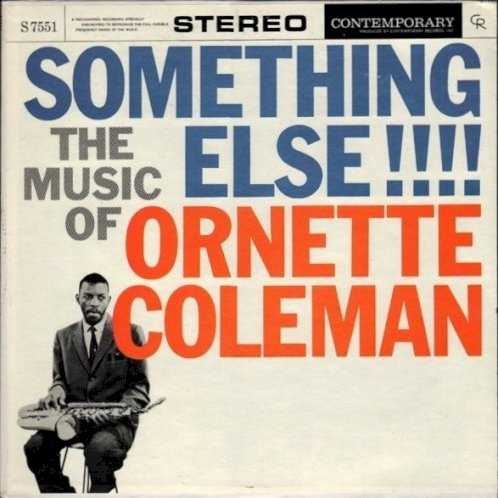 | Album: 1 of 40 Title: Something Else!!!!: The Music of Ornette Coleman Released: 1958 Tracks: 9 Duration: 42:59 Scroll: Up Down Top Bottom 25% 50% 75% Spotify Wikipedia Allmusic AlbumCover | 1 Invisible (04:17) 2 The Blessing (04:48) 3 Jayne (07:22) 4 Chippie (05:41) 5 The Disguise (02:51) 6 Angel Voice (04:24) 7 Alpha (04:15) 8 When Will the Blues Leave? (05:02) 9 The Sphinx (04:15) |
| Something Else!!!!: The Music of Ornette Coleman : Allmusic album Review : This 1958 debut recording by the Ornette Coleman Quintet, which featured Coleman on his trademark white plastic alto, Don Cherry on trumpet, Billy Higgins on drums, Walter Norris on piano, and Don Payne on bass, shook up the jazz world -- particularly those musicians and critics who had entered the hard bop era with such verve and were busy using the blues as a way of creating vast solo spaces inside tight and short melody lines. Something Else!!!! is anathema to that entire idea, and must have sounded like it came from outer space at the time. First, Colemans interest was in pitch, not "being in tune." His use of pitch could take him all over -- and outside of -- a composition, as it does on "Invisible," which begins in D flat. The intervals are standard, but the melodic component of the tune -- despite its hard bop tempo -- is, for the most part, free. But what is most compelling is evident in abundance here and on the next two tunes, "The Blessing" and "Jayne": a revitalization of the blues as it expressed itself in jazz. Coleman refurbished the blues framework, threaded it through his jazz without getting rid of its folk-like, simplistic milieu. In other words, the groove Coleman was getting here was a peoples groove that only confounded intellectuals at the time. Coleman restored blues to their "classic" beginnings in African music and unhooked their harmonies. Whether the key was D flat, A, G, whatever, Coleman revisited the 17- and 25-bar blues. There are normal signatures, however, such as "Chippie" in F and in eight-bar form, and "The Disguise" is in D, but in a strange 13-bar form where the first and the last change places, altering the talking-like voice inherent in the melodic line. But the most important thing about Something Else! was that, in its angular, almost totally oppositional way, it swung and still does; like a finger-poppin daddy on a Saturday night, this record swings from the rafters of the human heart with the most unusually gifted, emotional, and lyrical line since Bill Evans first hit the scene. | ||
 | Album: 2 of 40 Title: Tomorrow Is the Question! The New Music of Ornette Coleman! Released: 1959 Tracks: 9 Duration: 42:50 Scroll: Up Down Top Bottom 25% 50% 75% Wikipedia Allmusic AlbumCover | 1 Tomorrow Is the Question! (03:12) 2 Tears Inside (05:04) 3 Mind and Time (03:11) 4 Compassion (04:39) 5 Giggin’ (03:22) 6 Rejoicing (04:03) 7 Lorraine (05:59) 8 Turnaround (07:58) 9 Endless (05:17) |
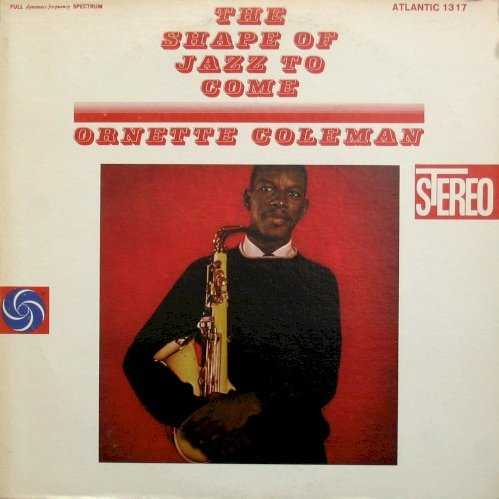 | Album: 3 of 40 Title: The Shape of Jazz to Come Released: 1959-10 Tracks: 6 Duration: 38:13 Scroll: Up Down Top Bottom 25% 50% 75% Spotify TrackSamples Wikipedia Allmusic AlbumCover | 1 Lonely Woman (05:02) 2 Eventually (04:22) 3 Peace (09:04) 4 Focus on Sanity (06:52) 5 Congeniality (06:48) 6 Chronology (06:03) |
| The Shape of Jazz to Come : Allmusic album Review : Ornette Colemans Atlantic debut, The Shape of Jazz to Come, was a watershed event in the genesis of avant-garde jazz, profoundly steering its future course and throwing down a gauntlet that some still havent come to grips with. The record shattered traditional concepts of harmony in jazz, getting rid of not only the piano player but the whole idea of concretely outlined chord changes. The pieces here follow almost no predetermined harmonic structure, which allows Coleman and partner Don Cherry an unprecedented freedom to take the melodies of their solo lines wherever they felt like going in the moment, regardless of what the pieces tonal center had seemed to be. Plus, this was the first time Coleman recorded with a rhythm section -- bassist Charlie Haden and drummer Billy Higgins -- that was loose and open-eared enough to follow his already controversial conception. Colemans ideals of freedom in jazz made him a feared radical in some quarters; there was much carping about his music flying off in all directions, with little direct relation to the original theme statements. If only those critics could have known how far out things would get in just a few short years; in hindsight, its hard to see just what the fuss was about, since this is an accessible, frequently swinging record. Its true that Colemans piercing, wailing alto squeals and vocalized effects werent much beholden to conventional technique, and that his themes often followed unpredictable courses, and that the groups improvisations were very free-associative. But at this point, Colemans desire for freedom was directly related to his sense of melody -- which was free-flowing, yes, but still very melodic. Of the individual pieces, the haunting "Lonely Woman" is a stone-cold classic, and "Congeniality" and "Peace" arent far behind. Any understanding of jazzs avant-garde should begin here. | ||
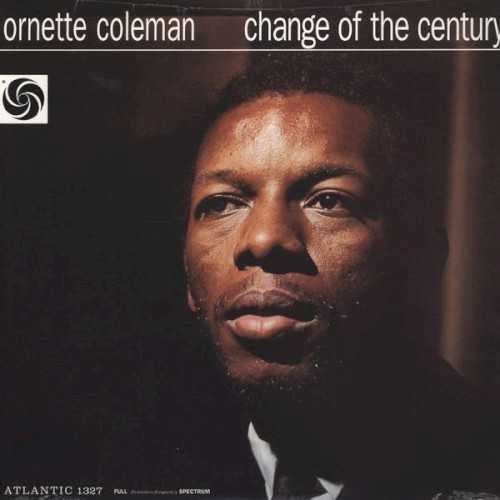 | Album: 4 of 40 Title: Change of the Century Released: 1960-06 Tracks: 7 Duration: 41:12 Scroll: Up Down Top Bottom 25% 50% 75% Spotify TrackSamples Wikipedia Allmusic AlbumCover | 1 Ramblin (06:36) 2 Free (06:20) 3 The Face of the Bass (06:55) 4 Forerunner (05:12) 5 Bird Food (05:27) 6 Una Muy Bonita (05:59) 7 Change of the Century (04:40) |
| Change of the Century : Allmusic album Review : The second album by Ornette Colemans legendary quartet featuring Don Cherry, Charlie Haden, and Billy Higgins, Change of the Century is every bit the equal of the monumental The Shape of Jazz to Come, showcasing a group that was growing ever more confident in its revolutionary approach and the chemistry in the bandmembers interplay. When Coleman concentrates on melody, his main themes are catchier, and when the pieces emphasize group interaction, the improvisation is freer. Two of Colemans most memorable classic compositions are here in their original forms -- "Ramblin" has all the swing and swagger of the blues, and "Una Muy Bonita" is oddly disjointed, its theme stopping and starting in totally unexpected places; both secure their themes to stable, pedal-point bass figures. The more outside group improv pieces are frequently just as fascinating; "Free," for example, features a double-tongued line that races up and down in free time before giving way to the ensembles totally spontaneous inventions. The title cut is a frantic, way-out mélange of cascading lines that nearly trip over themselves, brief stabs of notes in the lead voices, and jarringly angular intervals -- it must have infuriated purists who couldnt even stomach Colemans catchiest tunes. Coleman was frequently disparaged for not displaying the same mastery of instrumental technique and harmonic vocabulary as his predecessors, but his aesthetic prized feeling and expression above all that anyway. Maybe thats why Change of the Century bursts with such tremendous urgency and exuberance -- Coleman was hitting his stride and finally letting out all the ideas and emotions that had previously been constrained by tradition. That vitality makes it an absolutely essential purchase and, like The Shape of Jazz to Come, some of the most brilliant work of Colemans career. | ||
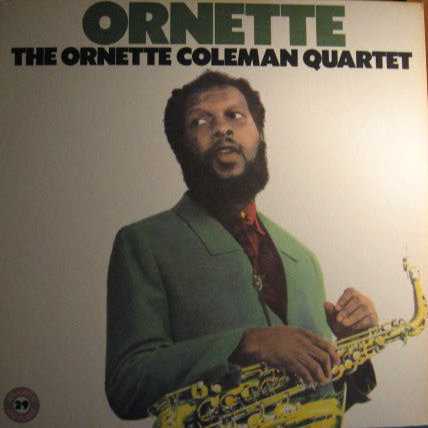 | Album: 5 of 40 Title: Ornette! Released: 1962-02 Tracks: 5 Duration: 54:28 Scroll: Up Down Top Bottom 25% 50% 75% Spotify Allmusic AlbumCover | 1 W.R.U. (16:28) 2 T. & T. (04:38) 3 C. & D. (13:13) 4 R.P.D.D. (09:43) 5 Proof Readers (10:25) |
| Ornette! : Allmusic album Review : Recorded a little over a month after his groundbreaking work Free Jazz, this album found Coleman perhaps retrenching from that idea conceptually, but nonetheless plumbing his quartet music to ever greater heights of richness and creativity. Ornette! was the first time bassist Scott LaFaro recorded with Coleman, and the difference in approach between LaFaro and Charlie Haden is apparent from the opening notes of "W.R.U." There is a more direct propulsion and limberness to his playing, and he can be heard driving Coleman and Don Cherry actively and more aggressively than Hadens warm, languid phrasing. The cuts, with titles derived from the works of Sigmund Freud, are all gems and serve as wonderful launching pads for the musicians improvisations. Coleman, by this time, was very comfortable in extended pieces, and he and his partners have no trouble filling in the time, never coming close to running out of ideas. Special mention should be made of Ed Blackwell, with one of his finest performances. Ornette! is a superb release and a must for all fans of Coleman and creative improvised music in general. | ||
 | Album: 6 of 40 Title: Ornette on Tenor Released: 1962-10 Tracks: 5 Duration: 41:12 Scroll: Up Down Top Bottom 25% 50% 75% Spotify Allmusic AlbumCover | 1 Cross Breeding (11:21) 2 Mapa (09:08) 3 Enfant (06:28) 4 Eos (06:37) 5 Ecars (07:37) |
| Ornette on Tenor : Allmusic album Review : Its an understatement to say that Ornette Colemans stint with Atlantic altered the jazz world forever, and Ornette on Tenor was the last of his six LPs (not counting outtakes compilations) for the label, wrapping up one of the most controversial and free-thinking series of recordings in jazz history. Actually, its probably his least stunning Atlantic, not quite as revolutionary or memorable as many of its predecessors, but still far ahead of its time. Coleman hadnt played much tenor since a group of Louisiana thugs beat him and destroyed his instrument, but he hadnt lost his affection for the tenors soulful, expressive honk and the ease with which people connected with it. That rationale might suggest a more musically accessible session, but that isnt the case. Ornette on Tenor is just as challenging and harmonically advanced as any of his previous Atlantics. In fact, its arguably more so, since there arent really any memorable themes to return to. That means there are fewer opportunities for Coleman and Don Cherry to interact and harmonize, which puts the focus mainly on Colemans return to tenor playing. And, actually, it isnt tremendously different from his alto playing. There are a few traces of Colemans early Texas gutbucket R&B; days, plus a few spots where he explores a breathier tone, but for the most part his spiraling solo lines are very similar to his other Atlantic albums, and his upper-register sound is often a dead ringer for his plaintive alto cries. With Coleman ostensibly exploring new territory, its hard not to be a little disappointed that Ornette on Tenor doesnt have the boundary-shattering impact of his previous work -- but then again, its probably asking too much to expect a revolution every time out. | ||
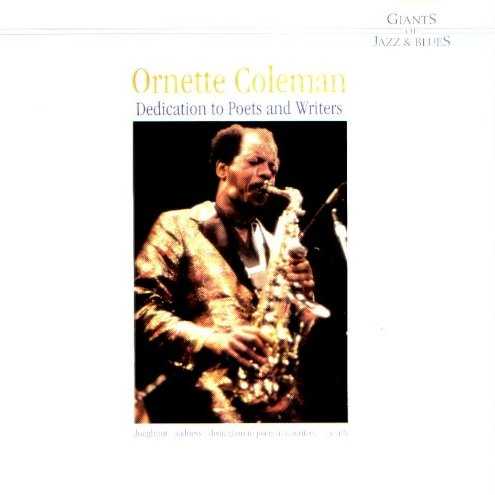 | Album: 7 of 40 Title: Town Hall 1962 Released: 1965 Tracks: 4 Duration: 47:09 Scroll: Up Down Top Bottom 25% 50% 75% Wikipedia AlbumCover | 1 Doughnut (09:32) 2 Sadness (04:25) 3 Dedication to Poets and Writers (09:21) 4 The Ark (23:49) |
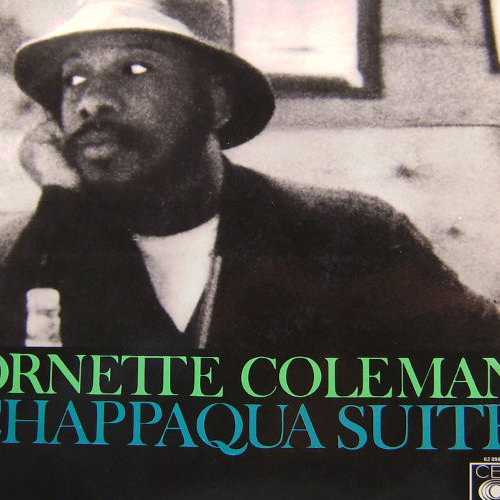 | Album: 8 of 40 Title: Chappaqua Suite Released: 1966 Tracks: 4 Duration: 1:19:19 Scroll: Up Down Top Bottom 25% 50% 75% Allmusic AlbumCover | 1 Part I (21:10) 2 Part II (18:41) 1 Part III (17:40) 2 Part IV (21:48) |
| Chappaqua Suite : Allmusic album Review : This four-part suite is actually a film soundtrack to the debut feature by Conrad Rooks, though it was never used as such. Recorded in 1965, it was performed by the Ornette Coleman Trio with Charles Moffett on drums and David Izenson on bass; augmenting the session were Pharoah Sanders on tenor and a large studio orchestra arranged by Joseph Tekula. What is most notable is the kind of control Coleman has over the orchestra. His trio is playing by intuition, which was normal for them, but they open to accommodate the more formal constructs of a band who knows little about improvisation and how it works in the free jazz context. Sanders interaction with Coleman is startling too, in that his normally overpowering voice is tempered here, playing along with the nuances and odd harmonic figures Coleman suggests and then blatantly states from his alto. The improvisation is complementary, not a cutting contest at all. Most of all, the rhythm section carries the balance of power and keeps the entire thing moving, handling the dynamic changes with a feral grace while at the same time suggesting a knottier path for Coleman to follow in the tempting pastoral sections of the work. While not considered a masterwork of Colemans, perhaps because of its unavailability in the United States in its entirety, Chappaqua Suite is a testament to Colemans vision as a composer and the power of his orchestral direction. Very worthwhile indeed. | ||
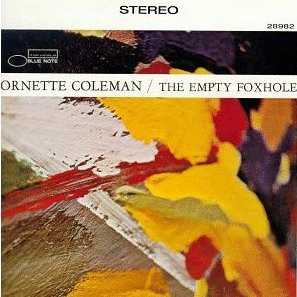 | Album: 9 of 40 Title: The Empty Foxhole Released: 1966 Tracks: 6 Duration: 38:47 Scroll: Up Down Top Bottom 25% 50% 75% Spotify Allmusic Wikipedia AlbumCover | 1 Good Old Days (06:49) 2 The Empty Foxhole (03:20) 3 Sound Gravitation (07:16) 4 Freeway Express (08:18) 5 Faithful (07:05) 6 Zig Zag (05:57) |
| The Empty Foxhole : Allmusic album Review : Ornette Colemans brief tenure at Blue Note was neither as seminal as his Atlantic output nor as brazenly ambitious as his early-70s work for Columbia and later with Prime Time. Still, the period did produce some quality music, and The Empty Foxhole is one of his most intriguing efforts. Coleman hadnt entered a recording studio in over four years when he returned -- with his ten-year-old son Denardo on drums. Coleman says in the liner notes that Denardo was ready to make a record the previous year, and hes not overestimating; Denardos percussive coloring and shading never sounds lost or confused, and his stream-of-consciousness flow of ideas keeps up surprisingly well with his father and bassist Charlie Haden. The communal energy keeps flowing throughout the session, and the trio members play off of each other with an easygoing enthusiasm, even on the less memorable themes. Most evocative are the funereal military march of the title track, where Ornettes mournful trumpet plays off of Denardos deliberate cadence, and "Sound Gravitation," a feature for Colemans scratchy, percussive violin. Of the alto-driven pieces, "Good Old Days" has the fieriest flow of ideas, but he seems energized by his sons presence, and his playing is fairly exciting throughout. On balance, the music may not be among Colemans most exceptional efforts, but theres something inspiring about the fact that The Empty Foxhole is as good as it is. | ||
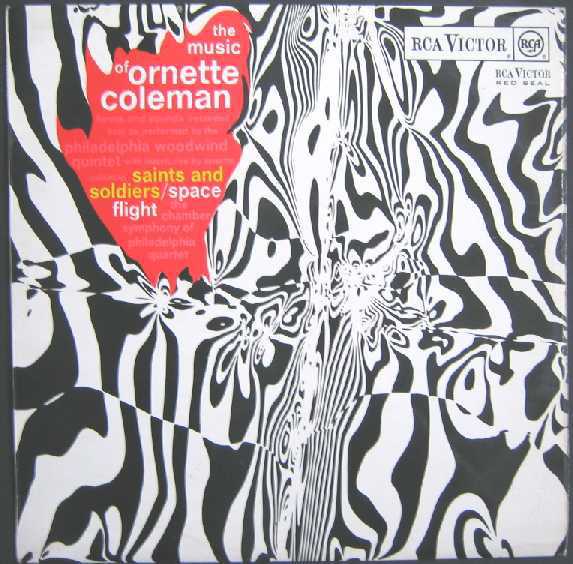 | Album: 10 of 40 Title: The Music of Ornette Coleman Released: 1967 Tracks: 3 Duration: 00:00 Scroll: Up Down Top Bottom 25% 50% 75% AlbumCover | 1 Forms and Sounds (?) 2 Saints and Soldiers (?) 3 Space Flight (?) |
 | Album: 11 of 40 Title: An Evening With Ornette Coleman Released: 1967 Tracks: 5 Duration: 36:47 Scroll: Up Down Top Bottom 25% 50% 75% AlbumCover | 1 Falling Stars (08:54) 2 Silence (09:13) 3 Happy Fool (07:11) 4 [untitled ballad] (05:19) 5 Doughnuts (06:10) |
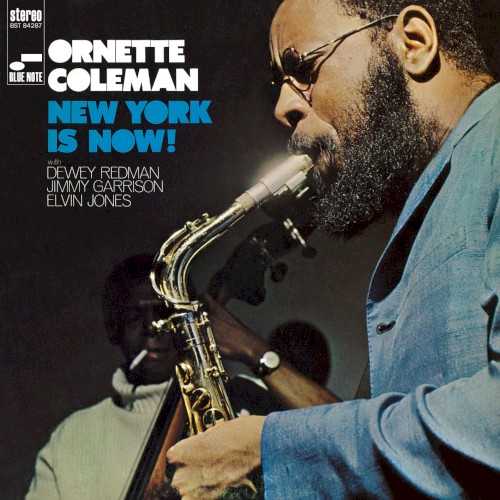 | Album: 12 of 40 Title: New York Is Now! Released: 1968 Tracks: 6 Duration: 47:25 Scroll: Up Down Top Bottom 25% 50% 75% Spotify Wikipedia AlbumCover | 1 The Garden of Souls (14:00) 2 Toy Dance (07:28) 3 Broad Way Blues (08:43) 4 Broad Way Blues (alternate version) (07:35) 5 Round Trip (06:18) 6 We Now Interrupt for a Commercial (03:19) |
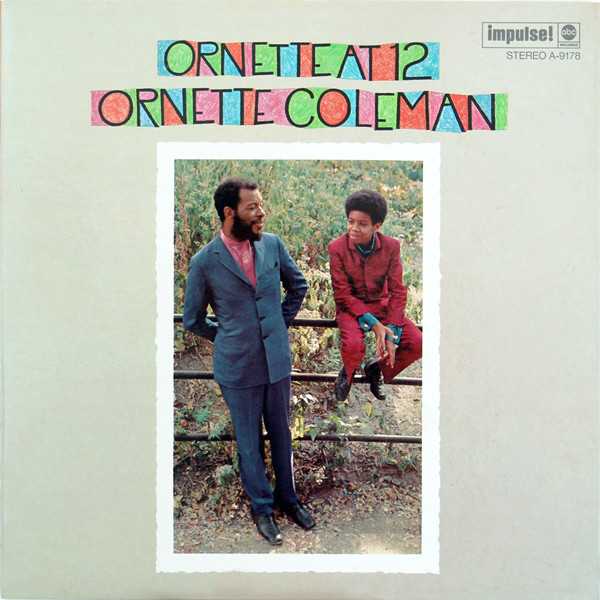 | Album: 13 of 40 Title: Ornette at 12 Released: 1969 Tracks: 4 Duration: 32:39 Scroll: Up Down Top Bottom 25% 50% 75% Wikipedia AlbumCover | 1 C.O.D. (07:40) 2 Rainbows (09:06) 3 New York (08:29) 4 Bells and Chimes (07:24) |
 | Album: 14 of 40 Title: The Art of the Improvisers Released: 1970-11-02 Tracks: 7 Duration: 45:25 Scroll: Up Down Top Bottom 25% 50% 75% Spotify Allmusic AlbumCover | 1 The Circle With a Hole in the Middle (04:53) 2 Just for You (03:54) 3 The Fifth of Beethoven (06:40) 4 The Alchemy of Scott La Faro (09:53) 5 Moon Inhabitants (04:36) 6 The Legend of Bebop (07:18) 7 Harlems Manhattan (08:11) |
| The Art of the Improvisers : Allmusic album Review : Like many of Ornette Colemans Atlantic sides, The Art of the Improvisers was recorded in numerous sessions from 1959-1961 and assembled for the purpose of creating a cohesive recorded statement. Its opening track, "The Circle with the Hole in the Middle," from 1959, with the classic quartet of Don Cherry, Ed Blackwell, and Charlie Haden, is one of Colemans recognizable pieces of music. Essentially, the band is that quartet with two very notable exceptions: The last tracks on each side feature a different bass player. On the end of side one, the great Scott LaFaro weighs in on "The Alchemy of Scott La Faro," and Jimmy Garrison weighs in on "Harlems Manhattan" to close the album out. These last two sessions were recorded early in 1961, in January and March respectively. As an album, The Art of the Improvisers is usually undervalued when placed next to This Is Our Music or The Shape of Jazz to Come. This is a mistake in that some of Colemans most deeply lyrical harmonic structures reside here in tracks such as "Just for You," with literally stunning intervallic interplay between him and Cherry from the middle to the end. The track also messes with standard blues form and comes up in a modal way without seemingly intending to. The set roars into "The Fifth of Beethoven," which collapses a series of flatted fifths around Haden and Cherry, and Coleman goes on a Texas blues spree in his solo, dancing all around them. "The Alchemy of Scott La Faro" must have pissed off the hard boppers like nothing else. Here is a straining sprint that the quartet takes in stride as LaFaro and Blackwell charge around the edges in frightening time signatures. Coleman and Cherry for the most part clamor around a B flat-C sharp major figure and run circles around each other in muscular fashion as LaFaro goes pizzicato to head with Coleman in the middle, turning the saxophonists phrases into rhythmic structures which Blackwell accents as if cued. But hes not; this is invented on the spot. Colemans deep lyricism shines through despite the tempo, and the entire thing goes out in a blaze of light. "The Legend of Bebop" is a jazz history lesson with the band working out on the front line, quoting from Sidney Bechet and Louis Armstrong, moving through some Ellingtonian themes, and slipping around the corner to a slow, blued-out bebop before taking off in consonant solos and counterpoint. "Harlems Manhattan," with Garrison in Hadens bass chair, begins with a quote right from Parker and Gillespie before challenging the framework of the blues and its tempos. Blackwell is a blur of the dance, his cymbal work against Garrisons punctuated accents make Colemans and Cherrys jobs knotty and difficult, but always rooted in the melody that blues inspires. This is basically one of Colemans most uptempo records for Atlantic, but also one of his most soulful. It deserves serious re-evaluation. | ||
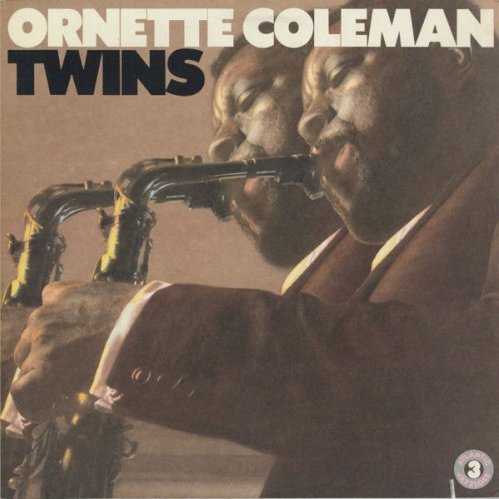 | Album: 15 of 40 Title: Twins Released: 1971-10-04 Tracks: 5 Duration: 42:35 Scroll: Up Down Top Bottom 25% 50% 75% Spotify Allmusic Wikipedia AlbumCover | 1 First Take (17:00) 2 Little Symphony (05:15) 3 Monk and the Nun (05:35) 4 Check Up (10:10) 5 Joy of a Toy (04:35) |
| Twins : Allmusic album Review : Ornette Colemans Twins (first issued on LP in 1971) has been looked at as an afterthought in many respects. A collection of sessions from 1959, 1960, and 1961 with different bands, they are allegedly takes from vinyl LP sessions commercially limited at that time to 40 minutes on vinyl, and not initially released until many years later. Connoisseurs consider this one of his better recordings in that it offers an overview of what Coleman was thinking in those pivotal years of the free bop movement rather than the concentrated efforts of The Art of the Improvisers, Change of the Century, The Shape of Jazz to Come, This Is Our Music, and of course the pivotal Free Jazz. There are three most definitive selections that define Colemans sound and concept. "Monk & the Nun" is angular like Thelonious Monk, soulful as spiritualism, and golden with the rhythm team of bassist Charlie Haden and drummer Billy Higgins driving the sweet and sour alto sax of Coleman and piquant trumpeting of Don Cherry. "Check Up" is a wild roller coaster ride, mixing meters, tempos, and dynamics in a blender in an unforgettable display of sheer virtuosity, and featuring bassist Scott LaFaro. "Joy of a Toy" displays the playful Ornette Coleman in interval leaps, complicated bungee jumps, in many ways whimsical but not undecipherable. It is one of the most intriguing of all of Colemans compositions. Less essential, "First Take" showcases his double quartet in a churning composition left off the original release This Is Our Music, loaded with interplay as a showcase for a precocious young trumpeter named Freddie Hubbard, the ribald bass clarinet of Eric Dolphy, and the first appearance with Colemans groups for New Orleans drummer Ed Blackwell. "Little Symphony" has a great written line with room for solos in a joyful hard bop center with the quartet of Coleman, Cherry, Haden, and Blackwell. All in all an excellent outing for Coleman from a hodgepodge of recordings that gives a broader view of his vision and the music that would come later in the 60s. | ||
 | Album: 16 of 40 Title: Science Fiction Released: 1972 Tracks: 8 Duration: 37:04 Scroll: Up Down Top Bottom 25% 50% 75% Spotify TrackSamples Allmusic Wikipedia AlbumCover | 1 What Reason Could I Give (03:07) 2 Civilization Day (06:05) 3 Street Woman (04:50) 4 Science Fiction (04:58) 5 Rock the Clock (03:17) 6 All My Life (03:56) 7 Law Years (05:22) 8 The Jungle Is a Skyscraper (05:26) |
| Science Fiction : Allmusic album Review : Ornette Colemans first album for Columbia followed a stint on Blue Note that found the altoist in something of a holding pattern. Science Fiction was his creative rebirth, a stunningly inventive and appropriately alien-sounding blast of manic energy. Coleman pulls out all the stops, working with a variety of different lineups and cramming the record full of fresh ideas and memorable themes. Bassist Charlie Haden and drummers Billy Higgins and/or Ed Blackwell are absolutely indispensable to the overall effect, playing with a frightening, whirlwind intensity throughout. The catchiest numbers -- including two songs with Indian vocalist Asha Puthli, which sound like pop hits from an alternate universe -- have spacy, long-toned melodies that are knocked out of orbit by the rhythm sections churning chaos, which often creates a totally different pulse. Two tracks reunite Colemans classic quartet of Haden, Higgins, and Don Cherry; "Street Woman" just wails, and "Civilization Day" is a furious, mind-blowing up-tempo burner. "Law Years" and "The Jungle Is a Skyscraper" feature a quintet with Haden, Blackwell, tenorist Dewey Redman, and trumpeter Bobby Bradford; both have racing, stop-start themes, and "Jungle"s solos have some downright weird groaning effects. "Rock the Clock" foreshadows Colemans 70s preoccupations, with Redman playing the musette (an Arabic double-reed instrument) and Haden amplifying his bass through a wah-wah pedal to produce sheets of distorted growls. The title track is a free septet blowout overlaid with David Hendersons echoed poetry recitations, plus snippets of a crying baby; it could sound awkward today, but in context its perfectly suited to the high-octane craziness all around it. Science Fiction is a meeting ground between Colemans past and future; it combines the fire and edge of his Atlantic years with strong hints of the electrified, globally conscious experiments that were soon to come. And, its overflowing with brilliance. | ||
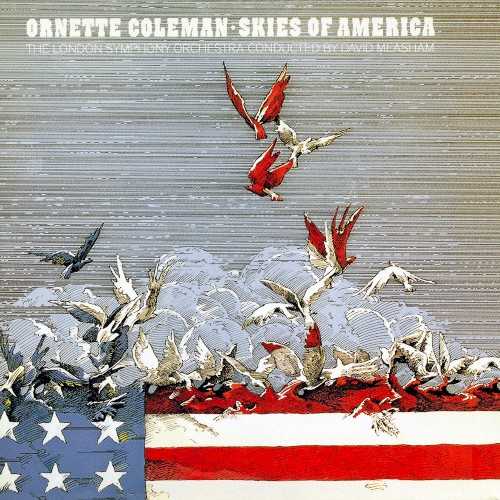 | Album: 17 of 40 Title: Skies of America Released: 1972 Tracks: 21 Duration: 41:23 Scroll: Up Down Top Bottom 25% 50% 75% Spotify Allmusic Wikipedia AlbumCover | 1 Skies of America (02:49) 2 Native Americans (01:10) 3 The Good Life (01:33) 4 Birthdays and Funerals (03:13) 5 Dreams (00:51) 6 Sounds of Sculpture (01:20) 7 Holiday for Heroes (01:10) 8 All of My Life (03:08) 9 Dancers (01:17) 10 The Souls Within Woman (00:47) 11 The Artist in America (03:54) 12 The New Anthem (00:31) 13 Place in Space (02:44) 14 Foreigner in a Free Land (01:19) 15 Silver Screen (01:10) 16 Poetry (01:15) 17 The Men Who Live in the White House (02:48) 18 Love Life (04:34) 19 The Military (00:32) 20 Jam Session (00:39) 21 Sunday in America (04:29) |
| Skies of America : Allmusic album Review : Heres what is known about Ornette Colemans first recorded orchestral symphonic work (he had written others previously and had them performed but never put on tape): After hiring conductor David Measham and the London Symphony Orchestra, British musicians union rules prohibited Coleman from using his own quartet to play on the record. As a result, he had to re-examine the work without the concerto grosso form and, to fit the work on a single LP, he had to cut many of the recurrent themes of the work. It is also known that the recording quality isnt the greatest. So what? The bottom line is this: In the 21st century, Skies of America, which was Ornettes first attempt at employing his newly developed harmolodic theory (whereby using modulation many players could solo at once using different keys), still sounds ahead of its time. Though there are 21 bands marked on the cover, this is a single unbroken work with many of the themes recurring -- either in that they had long been present in Ornettes musical iconography, or would become so. (Check the theme in "The Good Life," as it evolved from "School Work" from 1962 and became "Dancing in Your Head" in the late 70s.) Coleman himself solos beautifully in the middle of the disc, from "The Artist in America" on and off until the works end with "Sunday in America." This is loaded music: politically, emotionally, and also spiritually. The dissonance doesnt seem so profound now, but it still rubs against the grain of Western harmonic principles in all the right ways. Its difficult to find the sense of what chord is dominant in Colemans composition, and for that alone its valuable. But also, its compelling listening on a level that music such as this is not yet the cultural norm or even close to approaching its standard -- which means that it is not yet fully possible. Ornettes was an opening volley, thrown down as a gauntlet that has yet to be picked up. This is still dangerous and rewarding music. | ||
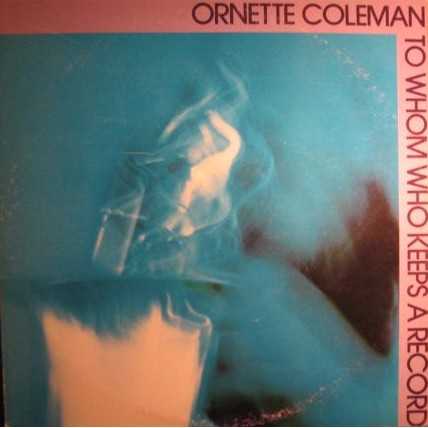 | Album: 18 of 40 Title: To Whom Who Keeps a Record Released: 1975 Tracks: 7 Duration: 40:17 Scroll: Up Down Top Bottom 25% 50% 75% Allmusic AlbumCover | 1 Music Always (05:31) 2 Brings Goodness (06:39) 3 To Us (04:36) 4 All (04:32) 5 P.S. Unless One Has (Blues Connotation No. 2) (05:55) 6 Some Other (07:23) 7 Motive for Its Use (05:41) |
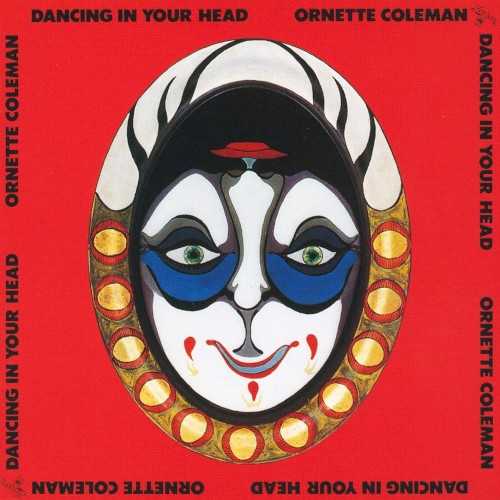 | Album: 19 of 40 Title: Dancing in Your Head Released: 1977 Tracks: 3 Duration: 31:26 Scroll: Up Down Top Bottom 25% 50% 75% Spotify TrackSamples Allmusic Wikipedia AlbumCover | 1 Theme From a Symphony (Variation One) (15:42) 2 Theme From a Symphony (Variation Two) (11:07) 3 Midnight Sunrise (04:36) |
| Dancing in Your Head : Allmusic album Review : Following the symphonic explorations of 1972s Skies of America, Ornette Coleman became fascinated with the music of Morocco. Dancing in Your Head is the chaotic result of that experimental period with the formation of Prime Time. "Theme From a Symphony" (Variation One and Two) is a 27-minute dervish whirlwind mixed with funk. This was the first opportunity listeners had to hear the two-guitar assault of Charles Ellerbee and Bern Nix. With its infectious danceable melody, Coleman fused these musics together in a unique unpredictable way that had not previously been attempted. "Midnight Sunrise" is a field recording with Ornette playing in Morocco alongside the Master Musicians of Jajouka during a religious ceremony. Music critic Robert Palmer, the first to expose Ornette to the music and culture of Morocco, plays clarinet. Unfortunately this fascinating piece clocks in at only 4:36, with an alternative take not on the original album, at 3:50 featuring Coleman and Palmer playing in an absolute frenzy. Dancing In Your Head sustained Ornette Colemans role of controversial innovator. | ||
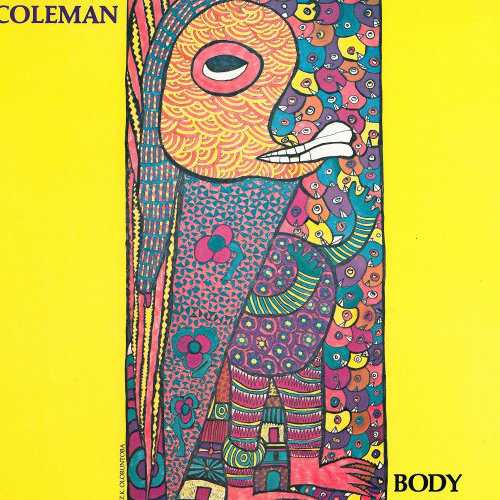 | Album: 20 of 40 Title: Body Meta Released: 1978 Tracks: 5 Duration: 41:56 Scroll: Up Down Top Bottom 25% 50% 75% Allmusic Wikipedia AlbumCover | 1 Voice Poetry (08:10) 2 Home Grown (07:47) 3 Macho Woman (07:43) 4 Fou Amour (08:36) 5 European Echoes (09:39) |
| Body Meta : Allmusic album Review : The establishment of Ornette Colemans self-determining Artists House label and his electric double-trio Prime Time coincided with the release of Body Meta, which changed many of the business and musical contours of jazz in the mid- to late 70s. Coleman proved that jazz musicians could determine their own fate and market their music without a major-label contract. He also advanced the orientation of jazz away from swing rhythms and into a deeper blues driven by funk and angular electric guitars inspired by the precepts of Thelonious Monk. A music that turned out to be crazier than most while attempting to be more people-oriented resulted in controversy. It was an indisputable new music amalgam that Coleman could claim as his own, yet which sprang forth into the so-called M-Base music movement of New York City. Jamaaladeen Tacuma on electric bass guitar, Bern Nix and Charlie Ellerbe on electric guitars, and drummers Denardo Coleman and Ronald Shannon Jackson comprise the first Prime Time band heard here. They are loud, boisterous, imaginative, unfettered by conventional devices, and wail beyond compare with Coleman within relatively funky, straight beats. "Voice Poetry" sets the tone, a boogaloo funk with an unmistakable kinship to the churning Bo Diddley beat, with Colemans obtuse alto sax between the guitarists obtuse castings creating intense, passionate, and obsessed music. Where "Home Grown" uses the same wall-rattling sound within repeated lines, there are dense and bulky layers embedded deeply in the thick rhythms. Fans of Coleman will relate more to "Macho Woman," which spurs on a sound similar to his style from years past, as the brief melody gives way to solos. "Fou Amour" is a soulful, off-minor, bitter ballad, while "European Echoes" is a militaristic waltz -- hardly a traipse through flowers -- with various free sections. As every track is different, Colemans vision has a diffuse focus, but its clear that things have changed. Even his personal sound is more pronounced, unleashed from shackles, and more difficult to pin down. | ||
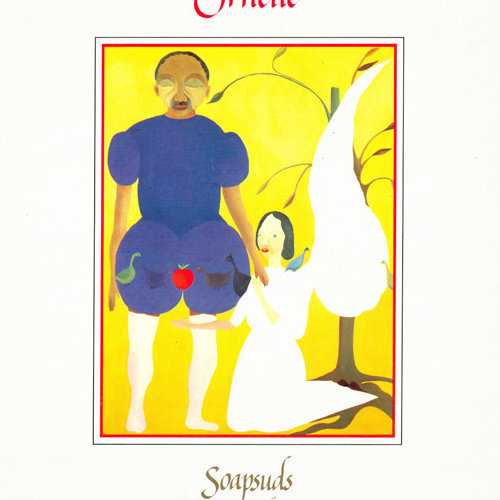 | Album: 21 of 40 Title: Soapsuds, Soapsuds Released: 1979 Tracks: 5 Duration: 38:24 Scroll: Up Down Top Bottom 25% 50% 75% Allmusic Wikipedia AlbumCover | 1 Mary Hartman, Mary Hartman (07:45) 2 Human Being (07:49) 3 Soap Suds (05:17) 4 Sex Spy (09:59) 5 Some Day (07:34) |
| Soapsuds, Soapsuds : Allmusic album Review : This unusual album found Coleman taking time off from his electric free funk group, Prime Time, to record acoustic duets with his longtime associate, bassist Charlie Haden. Coleman switches to tenor and trumpet for the challenging music which includes three of his originals, Hadens "Human Being" and oddly enough, the theme from the TV show Mary Hartman, Mary Hartman. Haden, who had proved to be the perfect bassist for the original Ornette Coleman Quartet (who else could have filled his shoes in 1959?), is the equal of Coleman on this 1996 reissue CD, inspiring the saxophonist to play near his peak. | ||
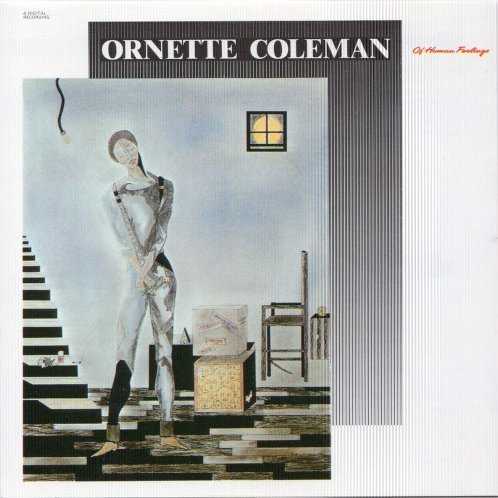 | Album: 22 of 40 Title: Of Human Feelings Released: 1982 Tracks: 8 Duration: 36:23 Scroll: Up Down Top Bottom 25% 50% 75% Spotify Allmusic Wikipedia AlbumCover | 1 Sleep Talk (03:34) 2 Jump Street (04:24) 3 Him and Her (04:20) 4 Air Ship (06:11) 5 What Is the Name of That Song? (03:58) 6 Job Mob (04:57) 7 Love Words (02:54) 8 Times Square (06:02) |
| Of Human Feelings : Allmusic album Review : When one thinks of Ornette Colemans innovative Prime Time Band, it is of crowded ensembles played by the altoist/leader, two guitars, two electric bassists, and two drummers. Actually, Jamaaladeen Tacuma, who plays enough for two musicians, is the only bassist on this date, but guitarists Charlie Ellerbee and Bern Nix, along with drummers Denardo Coleman and Calvin Weston, keep the ensembles quite exciting. None of the eight Coleman originals (which includes a tune titled "What Is the Name of That Song?") would catch on, but in this context they serve as a fine platform for Colemans distinctive horn and often witty and free (but oddly melodic) style. | ||
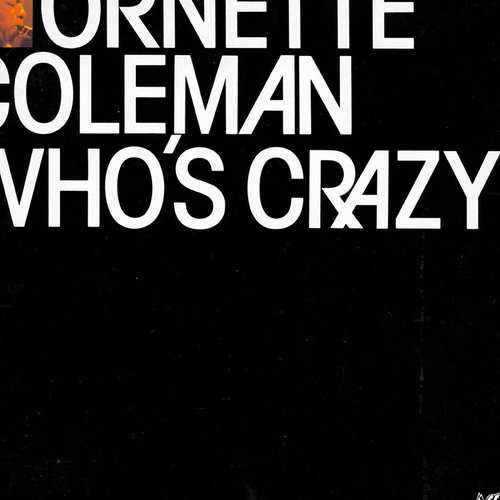 | Album: 23 of 40 Title: Whos Crazy? Released: 1982 Tracks: 6 Duration: 41:33 Scroll: Up Down Top Bottom 25% 50% 75% Allmusic AlbumCover | 1 January (04:29) 2 Sortie le Conqard (01:06) 3 Dans la Neige (07:44) 4 The Changes (10:03) 5 Better Get Yourself Another Self (09:17) 6 The Duel - Two Psychic Lovers and Eating Time (08:54) |
| Who's Crazy? : Allmusic album Review : This two-LP set contains the soundtrack Ornette Coleman and his trio contributed for the obscure Belgian film of the same name. Coleman (switching between alto, trumpet and violin), bassist Dave Izenzon and drummer Charles Moffett did not merely provide filler music but full-blown improvisations that stand very much on their own. Fans of Colemans very explorative music are advised to search for this valuable two-fer. | ||
 | Album: 24 of 40 Title: Broken Shadows Released: 1982 Tracks: 8 Duration: 50:07 Scroll: Up Down Top Bottom 25% 50% 75% Wikipedia AlbumCover | 1 Happy House (09:45) 2 Elizabeth (10:24) 3 School Work (05:38) 4 Country Town Blues (06:25) 5 Broken Shadows (06:40) 6 Rubber Gloves (03:22) 7 Good Girl Blues (03:05) 8 Is It Forever (04:48) |
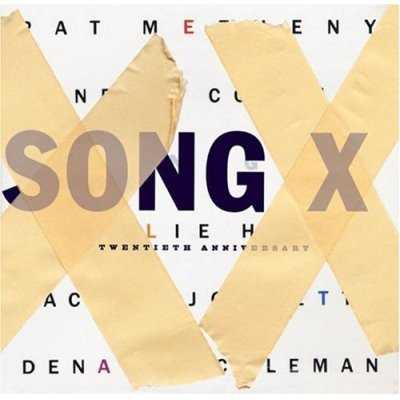 | Album: 25 of 40 Title: Song X Released: 1986 Tracks: 14 Duration: 1:06:55 Scroll: Up Down Top Bottom 25% 50% 75% Spotify Allmusic Wikipedia AlbumCover | 1 Police People (04:57) 2 All of Us (00:15) 3 The good life (03:25) 4 Word From Bird (03:48) 5 Compute (02:03) 6 The Veil (03:42) 7 Song X (05:38) 8 Mob Job (04:13) 9 Endangered Species (13:19) 10 Video Games (05:21) 11 Kathelin Gray (04:15) 12 Trigonometry (05:09) 13 Song X Duo (03:08) 14 Long Time No See (07:36) |
| Song X : Allmusic album Review : Guitarist Pat Metheny had long expressed admiration for Ornette Colemans music, had recorded his compositions, and had worked extensively with bassist Charlie Haden, so a collaboration was not totally unexpected, though who would have guessed that it would be on the Geffen label? Methenys almost rock star status has worked against him in other partnerships from time to time (notably, his overbearing playing on his project with Derek Bailey, The Sign of 4), but here he happily sublimates his showier instincts and works as sympathetic co-leader, deferring to Colemans experience and genius. The music itself bears strong similarities to that of Colemans Prime Time ensembles wherein all players solo at once, bracketed by the themes of the piece. Metheny often manages to be a quite expressive second voice, racing along beside the master saxophonist, offering alternative strategies and never showboating. The tandem percussion team of Jack DeJohnette and Colemans son Denardo are ferocious when need be, and Charlie Haden is his standard exemplary self. Metheny fans owe it to themselves to listen to some of his most exploratory and least "pastel" playing and, in fact, the album also contains some of Colemans best work since the mid-70s. | ||
 | Album: 26 of 40 Title: In All Languages Released: 1987-02 Tracks: 23 Duration: 1:13:29 Scroll: Up Down Top Bottom 25% 50% 75% Allmusic Wikipedia AlbumCover | 1 Peace Warriors (02:35) 2 Feet Music (03:32) 3 Africa Is the Mirror of All Colors (02:58) 4 Word for Bird (03:16) 5 Space Church (Continuous Services) (03:59) 6 Latin Genetics (03:39) 7 In All Languages (03:33) 8 Sound Manual (03:08) 9 Mothers of the Veil (03:45) 10 Cloning (03:14) 1 Music News (03:00) 2 Mothers of the Veil (04:28) 3 The Art of Love Is Happiness (02:29) 4 Latin Genetics (02:45) 5 Today, Yesterday and Tomorrow (03:10) 6 Listen Up (02:29) 7 Feet Music (03:49) 8 Space Church (Continuous Services) (04:34) 9 Cloning (02:28) 10 In All Languages (03:06) 11 Biosphere (02:20) 12 Story Tellers (02:49) 13 Peace Warriors (02:23) |
| In All Languages : Allmusic album Review : This is an unusual and very stimulating double CD. On the first CD, Ornette Coleman, on alto and tenor, has a reunion with his original quartet, which is comprised of trumpeter Don Cherry, bassist Charlie Haden and drummer Billy Higgins. The second CD features Colemans then-current edition of his "double quartet" Prime Time with guitarists Charlie Ellerbe and Bern Nix, electric bassists Jamaaladeen Tacuma and Al MacDowell, and drummers Denardo Coleman and Calvin Weston. Five of the ten songs the quartet plays are also heard in versions by Prime Time, and the latter electric group almost makes the acoustic unit sound conservative in comparison. While the quartet displays subtle use of space and interplay between the musicians, Prime Time comes across as overcrowded and loud, but no less stimulating. Highly recommended to fans of Ornette Coleman. | ||
 | Album: 27 of 40 Title: Virgin Beauty Released: 1988 Tracks: 11 Duration: 45:18 Scroll: Up Down Top Bottom 25% 50% 75% Spotify Allmusic AlbumCover | 1 3 Wishes (04:23) 2 Bourgeois Boogie (05:11) 3 Happy Hour (04:49) 4 Virgin Beauty (03:34) 5 Healing the Feeling (05:21) 6 Singing in the Shower (04:26) 7 Desert Players (04:24) 8 Honeymooners (04:24) 9 Chanting (03:01) 10 Spelling the Alphabet (01:30) 11 Unknown Artist (04:12) |
| Virgin Beauty : Allmusic album Review : This CD is often quite exciting, if a bit messy. Ornette Coleman (on alto, trumpet and violin) is heard with his "double quartet" Prime Time, which at the time was comprised of guitarists Bern Nix and Charlie Ellerbee, electric bassists Al MacDowell and Chris Walker, and drummers Denardo Coleman (who also plays some keyboards) and Calvin Weston. As if the ensembles are not dense and overcrowded enough, Jerry Garcia sits in on third guitar on three of the 11 Coleman originals. The music is frequently exciting, but will take several listens to absorb. Worth investigating. | ||
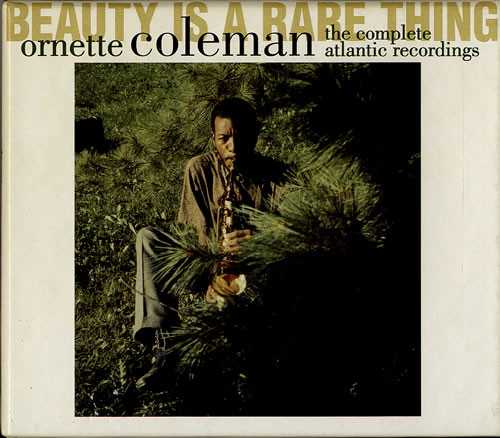 | Album: 28 of 40 Title: Beauty Is a Rare Thing Released: 1993-11-16 Tracks: 57 Duration: 7:06:19 Scroll: Up Down Top Bottom 25% 50% 75% Spotify AlbumCover | 1 Focus on Sanity (06:51) 2 Chronology (06:07) 3 Peace (09:04) 4 Congeniality (06:48) 5 Lonely Woman (04:59) 6 Monk and the Nun (05:56) 7 Just for You (03:53) 8 Eventually (04:22) 9 Una Muy Bonita (06:00) 10 Bird Food (05:30) 11 Change of the Century (04:44) 12 Music Always (05:29) 1 The Face of the Bass (06:57) 2 Forerunner (05:15) 3 Free (06:22) 4 The Circle With a Hole in the Middle (04:53) 5 Ramblin’ (06:37) 6 Little Symphony (05:16) 7 The Tribes of New York (04:34) 8 Kaleidoscope (06:36) 9 Rise and Shine (06:13) 10 Mr. and Mrs. People (04:42) 11 Blues Connotation (05:18) 12 I Heard It Over the Radio (06:23) 1 P.S. Unless One Has (Blues Connotation No. 2) (05:54) 2 Revolving Doors (04:28) 3 Brings Goodness (06:39) 4 Joy of a Toy (04:57) 5 To Us (04:36) 6 Humpty Dumpty (05:24) 7 The Fifth of Beethoven (06:37) 8 Motive for Its Use (05:41) 9 Moon Inhabitants (04:33) 10 The Legend of Bebop (07:18) 11 Some Other (07:23) 12 Embraceable You (04:56) 13 All (04:30) 1 Folk Tale (04:48) 2 Poise (04:38) 3 Beauty Is a Rare Thing (07:14) 4 First Take (17:05) 5 Free Jazz (37:03) 1 Proof Readers (10:27) 2 W.R.U. (16:27) 3 Check Up (10:11) 4 T. & T. (04:38) 5 C. & D. (13:12) 6 R.P.D.D. (09:40) 7 The Alchemy of Scott LaFaro (09:49) 1 Eos (06:37) 2 Enfant (06:28) 3 Ecars (07:37) 4 Cross Breeding (11:21) 5 Harlem’s Manhattan (08:11) 6 Mapa (09:07) 7 Abstraction (04:10) 8 Variants on a Theme of Thelonious Monk (Criss-Cross): Variant I / Variant II / Variant III / Variant IV (15:22) |
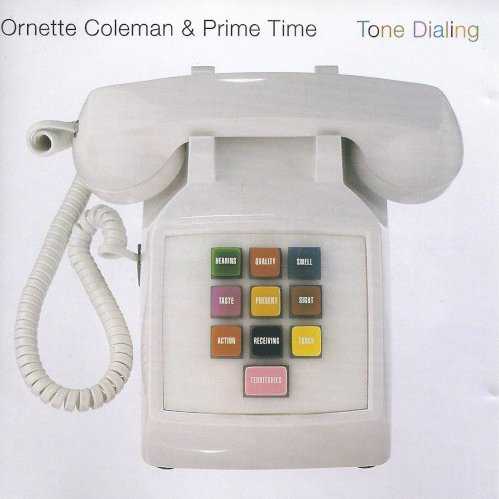 | Album: 29 of 40 Title: Tone Dialing Released: 1995-09-26 Tracks: 16 Duration: 1:06:00 Scroll: Up Down Top Bottom 25% 50% 75% Allmusic AlbumCover | 1 Street Blues (05:01) 2 Search for Life (07:39) 3 Guadalupe (04:08) 4 Bach Prelude (05:41) 5 Sound Is Everywhere (03:34) 6 Miguels Fortune (06:06) 7 La Capella (04:32) 8 OAC (02:48) 9 If I Knew as Much About You (as You Know About Me) (02:33) 10 When Will I See You Again (02:47) 11 Kathelin Gray (04:38) 12 Badal (04:36) 13 Tone Dialing (01:50) 14 Family Reunion (04:07) 15 Local Instinct (02:56) 16 Ying Yang (02:56) |
| Tone Dialing : Allmusic album Review : Ornette Colemans first album in several years and first recording for a major label in quite some time features his 1995 version of Prime Time with two guitars, two bassists, son Denardo Coleman on drums and Badal Roy on tables and percussion. In addition the band includes Dave Bryant, Colemans first keyboardist in decades (although his part is actually fairly minor). The ensembles are funky and quite dense, Coleman really wails on alto (also playing a bit of violin and trumpet) and, despite the inclusion of one obnoxious rap, this free funk set is well worth picking up by open-minded listeners. | ||
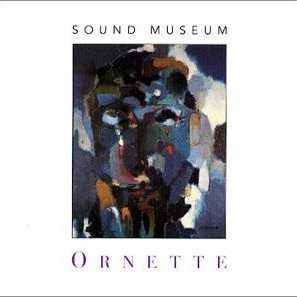 | Album: 30 of 40 Title: Sound Museum: Hidden Man Released: 1996 Tracks: 14 Duration: 50:46 Scroll: Up Down Top Bottom 25% 50% 75% AlbumCover | 1 Sound Museum (06:16) 2 Monsieur Allard (02:56) 3 City Living (03:21) 4 What Reason (04:19) 5 Home Grown (03:08) 6 Stopwatch (02:25) 7 Women of the Veil (04:41) 8 P.P. (Picolo Pesos) (02:50) 9 Biosphere (03:11) 10 Yesterday, Today, & Tomorrow (04:10) 11 European Echoes (03:18) 12 What a Friend We Have in Jesus (Variation) (04:38) 13 Mob Job (03:10) 14 Macho Woman (02:17) |
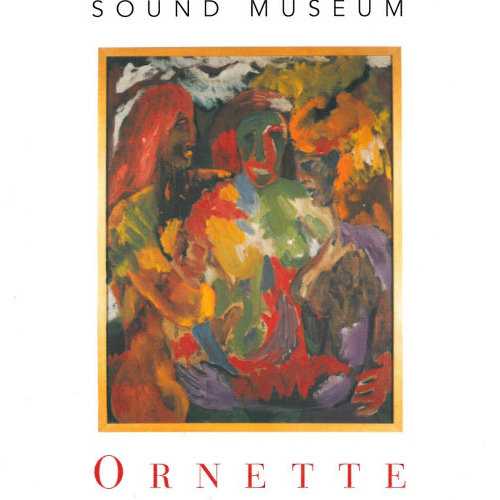 | Album: 31 of 40 Title: Sound Museum: Three Women Released: 1996 Tracks: 14 Duration: 55:13 Scroll: Up Down Top Bottom 25% 50% 75% Allmusic AlbumCover | 1 Sound Museum (04:54) 2 Monsieur Allard (02:47) 3 City Living (03:31) 4 What a Reason (04:58) 5 Home Grown (03:22) 6 Stopwatch (02:27) 7 Dont You Know by Now (04:23) 8 P.P. (Picolo Pesos) (03:23) 9 Women of the Veil (04:48) 10 Yesterday, Today & Tomorrow (04:14) 11 Biosphere (04:22) 12 European Echoes (04:57) 13 Mob Job (04:21) 14 Macho Woman (02:41) |
| Sound Museum: Three Women : Allmusic album Review : In 1996, altoist Ornette Coleman simultaneously released a pair of 14-song CDs; 13 of his pieces are heard in different versions on both releases. Joined by a particularly stimulating rhythm section (pianist Geri Allen, bassist Charnett Moffett and drummer Denardo Coleman), Coleman (who also contributes some trumpet and violin) is in superior form throughout the performances. On "Dont You Know By Now" (the one tune that is only heard on this CD), Lauren Kinhan and Chris Walker take passionate vocals. Otherwise, this is an excellent showcase for Ornettes searching and emotional (yet melodic) improvisations, one of the very few occasions since 1958 when he can be heard using a conventional three-piece rhythm section. | ||
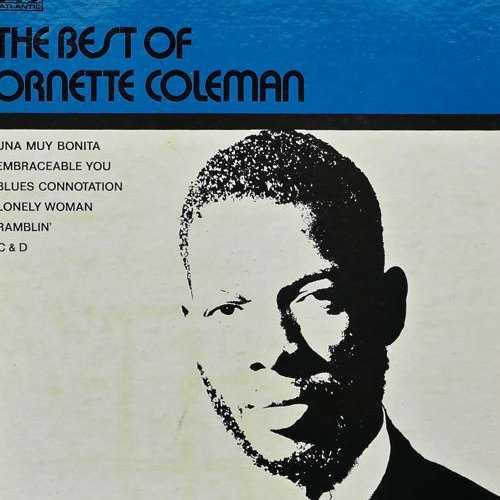 | Album: 32 of 40 Title: The Best of Ornette Coleman Released: 1998-03-10 Tracks: 7 Duration: 56:57 Scroll: Up Down Top Bottom 25% 50% 75% Spotify AlbumCover | 1 Broadway Blues (08:40) 2 Round Trip (06:15) 3 Dawn (08:10) 4 Dee Dee (10:26) 5 Zig Zag (05:57) 6 Good Old Days (06:47) 7 Old Gospel (10:42) |
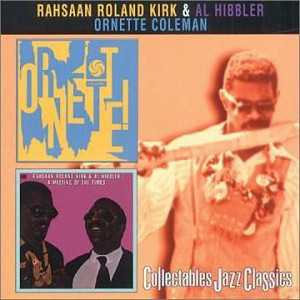 | Album: 33 of 40 Title: A Meeting of the Times / Ornette! Released: 1999 Tracks: 12 Duration: 1:15:44 Scroll: Up Down Top Bottom 25% 50% 75% AlbumCover | 1 Do Nothin Till You Hear from Me (04:42) 2 Daybreak (03:15) 3 Lover, Come Back to Me (03:51) 4 Dont Get Around Much Anymore (02:56) 5 This Love of Mine (04:56) 6 Carney and Bigard Place (05:36) 7 I Didnt Know About You (04:04) 8 Dream (02:31) 9 W.R.U. (16:26) 10 T. & T. (04:38) 11 C. & D. (13:11) 12 R.P.D.D. (09:37) |
 | Album: 34 of 40 Title: The Complete Science Fiction Sessions Released: 2000-05-02 Tracks: 19 Duration: 1:49:00 Scroll: Up Down Top Bottom 25% 50% 75% Spotify Allmusic AlbumCover | 1 What Reason Could I Give (03:07) 2 Civilization Day (06:05) 3 Street Woman (04:50) 4 Science Fiction (05:02) 5 Rock the Clock (03:17) 6 All My Life (03:56) 7 Law Years (05:22) 8 The Jungle Is a Skyscraper (05:26) 9 School Work (05:36) 10 Country Town Blues (06:25) 11 Street Woman (alternate take) (05:46) 12 Civilization Day (alternate mix) (06:04) 1 Happy House (09:46) 2 Elizabeth (10:26) 3 Written Word (09:44) 4 Broken Shadows (06:42) 5 Rubber Gloves (03:24) 6 Good Girl Blues (03:05) 7 Is It Forever (04:49) |
| The Complete Science Fiction Sessions : Allmusic album Review : Finally, on a pair of CDs in one collection are the rest of Ornette Colemans Columbia recordings, all of them done before Skies of America. Science Fiction was a regular part of Columbias jazz catalogue, and Broken Shadows was released on LP in 1982. On this double set, both of those records and three previously unreleased cuts from those sessions are together at last. Coleman assembled mostly alumni for his September 1971 sessions in the Columbia studios. The sizes of the ensembles range from septet to quartet to up to 11 players. His classic early bands are reunited here with trumpeter Don Cherry, saxophonist Dewey Redman, bassist Charlie Haden, and drummers Ed Blackwell and Billy Higgins. Augmenting these bands in places are pianist Cedar Walton, guitarist Jim Hall, trumpeter Bobby Bradford, vocalist Asha Puthi, and Science Fiction narrator, poet David Henderson. The swinging weirdness quotient is high on Science Fiction, especially on "What Reason Could I Give," "Street Woman," and "Civilization Day." The title track is an out, free-blowing fest that sounds hopelessly dated but is still cool, and on the tracks "School Work," "Broken Shadows," and "Happy House," listeners hear the first traces of the themes Coleman continues to employ. The inclusion of alternate takes offers the listener a cleaner view of the kind of harmonic theory Coleman was working against when he created harmolodics. Some of the oddities on these sessions are the seeming incongruities between Redman and Hall on "Good Girl Blues," with Webster Armstrongs singing with Waltons piano and Coleman just undermining the entire thing, trying to force another dimension out of the blues, or perhaps a new one into them. Elsewhere, on "Rock the Clock," listeners hear Colemans first experiments with electricity, with a funky backbeat straining to maintain itself against his sawing violin, note-spattering trumpet; then there are Redmans bluesy post-bop chromatics (quoting Brubecks "Take Five" in his solo) moving atop a funky doubled-up backbeat and one scary amplified Charlie Haden bass. Science Fiction is a stellar collection of Ornette-ology assembled in one place. This is some of his very best material, archived and issued the way it should have been in the first place. | ||
 | Album: 35 of 40 Title: Ken Burns Jazz Released: 2000-11-07 Tracks: 11 Duration: 1:16:05 Scroll: Up Down Top Bottom 25% 50% 75% Spotify Allmusic AlbumCover | 1 The Sphinx (04:18) 2 Congeniality (06:48) 3 Lonely Woman (05:02) 4 Ramblin (06:38) 5 Embraceable You (04:56) 6 Blues Connotation (05:19) 7 First Take (17:05) 8 European Echoes (07:47) 9 Law Years (05:22) 10 The Good Life (01:37) 11 Theme From a Symphony (Variation 2) (11:09) |
| Ken Burns Jazz : Allmusic album Review : In conjunction with the release of Ken Burns ten-part, 19-hour epic PBS documentary Jazz, Columbia issued 22 single-disc compilations devoted to jazzs most significant artists, as well as a five-disc historical summary. Since the individual compilations attempt to present balanced overviews of each artists career, tracks from multiple labels have thankfully been licensed where appropriate. The Ornette Coleman installment of Ken Burns Jazz naturally concentrates on his hugely influential recordings for Atlantic, but also devotes four of the 11 tracks to his equally controversial 70s output, including the electric Prime Time band. Given the limitations of the single-disc format, the compilers have successfully represented the most important phases of Colemans career. Theres one piece from his formative pre-Atlantic years, which is followed by several less structured yet melodic Coleman classics like "Lonely Woman" and "Ramblin," plus his legendary inside-out version of "Embraceable You." Colemans Free Jazz (A Collective Improvisation) album was a landmark, but including its one 37-minute track would hardly have made for a balanced retrospective, so the compilers instead wisely chose "First Take," a sort of dry run for Free Jazz thats less than half that length and appeared on the Atlantic box. Theres also one selection apiece from the frequently fascinating 70s albums Science Fiction, Skies of America, Dancing in Your Head, and Body Meta, which found Coleman experimenting with world music, large orchestras, and electric funk/free jazz fusion. The only glaring omission is the classic "Una Muy Bonita," probably Colemans secondary signature tune after "Lonely Woman." Of course, theres a lot more Coleman that should be heard, but all things considered -- especially since it draws from multiple labels -- Ken Burns Jazz is likely the most comprehensive single-disc Coleman compilation that will ever be released. | ||
 | Album: 36 of 40 Title: Original Album Series Released: 2011-06-13 Tracks: 26 Duration: 3:19:44 Scroll: Up Down Top Bottom 25% 50% 75% Allmusic AlbumCover | 1 Lonely Woman (05:02) 2 Eventually (04:22) 3 Peace (09:03) 4 Focus on Sanity (06:51) 5 Congeniality (06:47) 6 Chronology (06:05) 1 Ramblin (06:40) 2 Free (06:25) 3 The Face of the Bass (07:00) 4 Forerunner (05:16) 5 Bird Food (05:31) 6 Uma Muy Bonita (06:02) 7 Change of the Century (04:42) 1 Blues Connotation (05:17) 2 Beauty Is a Rare Thing (07:13) 3 Kaleidoscope (06:36) 4 Embraceable You (04:55) 5 Poise (04:41) 6 Humpty Dumpty (05:24) 7 Folk Tale (04:45) 1 Free Jazz, Part 1 (19:37) 2 Free Jazz: Part 2 (17:30) 1 W.R.U. (16:28) 2 T. & T. (04:38) 3 C. & D. (13:12) 4 R.P.D.D. (09:42) |
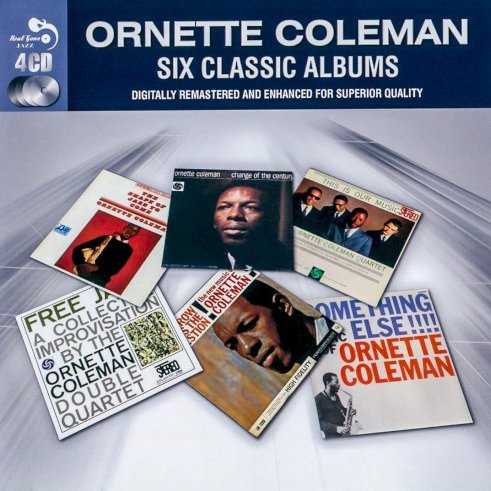 | Album: 37 of 40 Title: Six Classic Albums Released: 2013 Tracks: 39 Duration: 4:01:37 Scroll: Up Down Top Bottom 25% 50% 75% AlbumCover | 1 Lonely Women (05:01) 2 Eventually (04:22) 3 Peace (09:04) 4 Focus on Sanity (06:52) 5 Congeniality (06:48) 6 Chronology (06:03) 7 Blues Connotation (05:18) 8 Beauty Is a Rare Thing (07:14) 9 Kaleidoscope (06:36) 10 Embraceable You (04:56) 11 Poise (04:38) 12 Humpty Dumpty (05:24) 13 Folk Tale (04:48) 1 Ramblin (06:38) 2 Free (06:24) 3 The Face of the Bass (06:57) 4 Forerunner (05:16) 5 Bird Food (05:31) 6 Una Muy Bonita (06:02) 7 Change of the Century (04:41) 8 Free Jazz (37:03) 1 Invisible (04:17) 2 The Blessing (04:48) 3 Jayne (07:22) 4 Chippie (05:41) 5 The Disguise (02:51) 6 Angel Voice (04:24) 7 Alpha (04:15) 8 When Will the Blues Leave? (05:02) 9 The Sphinx (04:15) 1 Tomorrow Is the Question! (03:12) 2 Tears Inside (05:04) 3 Mind and Time (03:11) 4 Compassion (04:39) 5 Giggin (03:22) 6 Rejoicing (04:03) 7 Lorraine (05:59) 8 Turnabout (07:58) 9 Endless (05:17) |
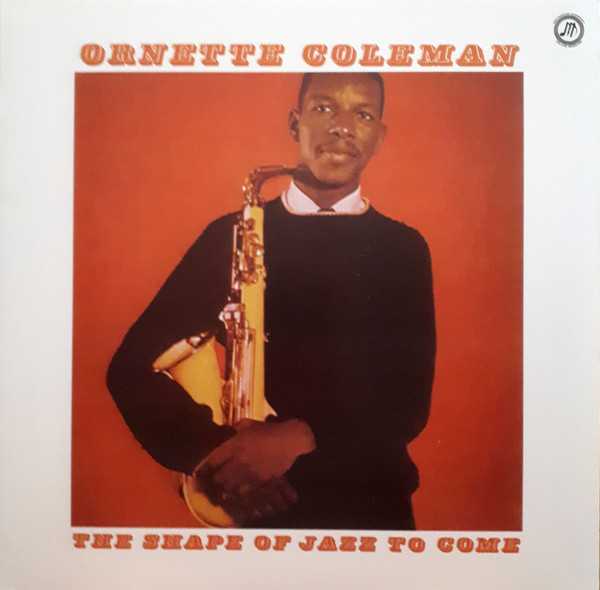 | Album: 38 of 40 Title: Coleman Classics 1 Released: 2016-02-29 Tracks: 6 Duration: 50:12 Scroll: Up Down Top Bottom 25% 50% 75% AlbumCover | 1 When Will The Blues Leave (14:06) 2 Crossroads (01:54) 3 Ramblin (14:09) 4 How Deep Is The Ocean (04:49) 5 The Blessing (09:36) 6 Free (05:38) |
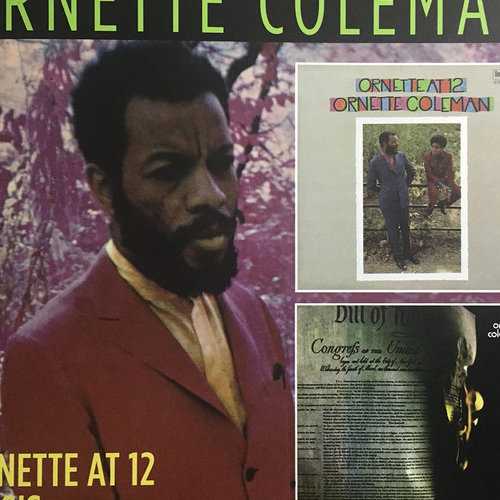 | Album: 39 of 40 Title: Ornette at 12/Crisis Released: 2017-09-08 Tracks: 9 Duration: 1:17:30 Scroll: Up Down Top Bottom 25% 50% 75% Allmusic AlbumCover | 1 C.O.D. (07:42) 2 Rainbows (09:10) 3 New York (08:30) 4 Bells and Chimes (07:28) 5 Broken Shadows (06:08) 6 Comme il faut (14:33) 7 Song for Che (11:39) 8 Space Jungle (05:31) 9 Trouble in the East (06:49) |
| Ornette at 12/Crisis : Allmusic album Review : Beginning in 1966, saxophonist Ornette Coleman began performing and recording with his son, the then-ten-year-old drummer Denardo Coleman. Dismissed by some at the time for his lack of experience, the younger Coleman quickly developed into an engaging, explosive player, able to mesh nicely within his fathers deeply avant-garde free jazz ensembles. The 2017 Real Gone Music collection Ornette at 12/Crisis brings together two live albums Denardo recorded with his father in 1969 and 1972. The first, Ornette at 12 (named after Denardos age at the time of recording), finds the saxophonist leading his quartet through a performance at the Hearst Greek Amphitheater at the University of California, Berkeley in August of 1968. Joining him are bassist Charlie Haden and tenor saxophonist Dewey Redman. Here we find the elder Coleman during one of his most primal and exploratory periods playing not just alto sax, but also trumpet and violin. Though untrained on those instruments, he still lets loose, playing with unfettered glee on "Rainbows," his trumpet a puckish sparkler of sound. Similarly, Redman, framed by Hadens bowed bass squelch, unleashes a torrent of notes on "C.O.D." All the while, Denardo is skittering, responsive energy, bashing and sputtering at each improvisational line. Elsewhere, on "Bells and Chimes," Haden grounds the proceedings bowing a dark, heavy metal-sounding riff as Coleman and Redman spew red saxophone storm clouds overhead. An even more adept picture of the drummer can be heard on Crisis. Recorded roughly a year after Ornette at 12, the album showcases the groups performance at New York University. Augmenting the ensemble is the elder Colemans longtime collaborator, pocket-trumpeter Don Cherry, whose distinctive, fractured melodicism helps further color the already vibrant group. His inclusion also adds gravitas, helping fill out the sound of the group, as heard on the opening "Broken Shadows," in which the band slowly lurches forward like an immense ocean liner entering port. In contrast, "Space Jungle" finds Denardo whacking away with spastic intensity as the horn players ride his wave with a group improv rife with serpentine harmolodic invention. There is even a nod to the groups burgeoning interest in various ethnic and world music traditions on the closing "Trouble in the East." The song begins with Cherry at the front like an avant-garde pied piper delivering a ferocious Indian flute solo. Soon, Coleman, Redman, and Haden join in, their dissonant tones caught in the tumult of Denardos drumming and a cacophony of what sounds like tin pans, shakers, and bamboo sticks. These live albums document Colemans further move away from musical form and his increasing embrace of free improvisation as a direct line to emotional and artistic expression. Ultimately, that expression has even more of an impact because of the presence of Denardos intense, youthful exuberance. | ||
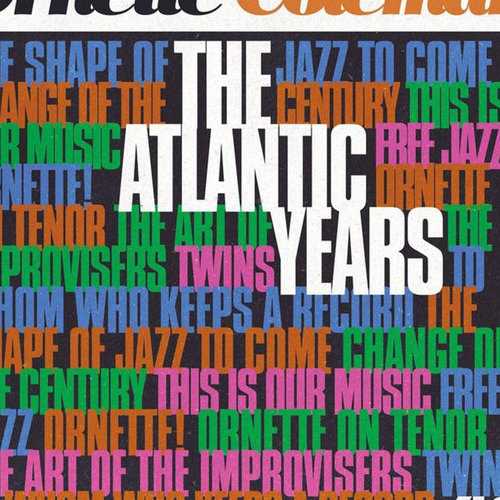 | Album: 40 of 40 Title: The Atlantic Years Released: 2018 Tracks: 56 Duration: 00:00 Scroll: Up Down Top Bottom 25% 50% 75% Spotify AlbumCover | 1 Lonely Woman (?) 2 Eventually (?) 3 Peace (?) 4 Focus on Sanity (?) 5 Congeniality (?) 6 Chronology (?) 1 Ramblin (?) 2 Free (?) 3 The Face of the Bass (?) 4 Forerunner (?) 5 Bird Food (?) 6 Una Muy Bonita (?) 7 Change of the Century (?) 1 Blues Connotation (?) 2 Beauty Is a Rare Thing (?) 3 Kaleidoscope (?) 4 Embraceable You (?) 5 Poise (?) 6 Humpty Dumpty (?) 7 Folk Tale (?) 1 Free Jazz (Part 1) (?) 2 Free Jazz (Part 2) (?) 1 WRU (?) 2 T & T (?) 3 C & D (?) 4 R.P.D.D. (?) 1 Cross Breeding (?) 2 Mapa (?) 3 Enfant (?) 4 EOS (?) 5 Ecars (?) 1 The Circle With a Hole in the Middle (?) 2 Just for You (?) 3 The Fifth of Beethoven (?) 4 The Alchemy of Scott Lafaro (?) 5 Moon Inhabitants (?) 6 The Legend of Bebop (?) 7 Harlems Manhattan (?) 1 First Take (?) 2 Little Symphony (?) 3 Monk and the Nun (?) 4 Check Up (?) 5 Joy of a Toy (?) 1 Music Always (?) 2 Brings Goodness (?) 3 To Us (?) 4 All (?) 5 P.S. Unless One Has (Blues Connotation No. 2) (?) 6 Some Other (?) 7 Motive for Its Use (?) 1 Rise and Shine (?) 2 The Tribes of New York (?) 3 I Heard It Over the Radio (?) 4 Revolving Doors (?) 5 Mr. And Mrs. People (?) 6 Proof Readers (?) |